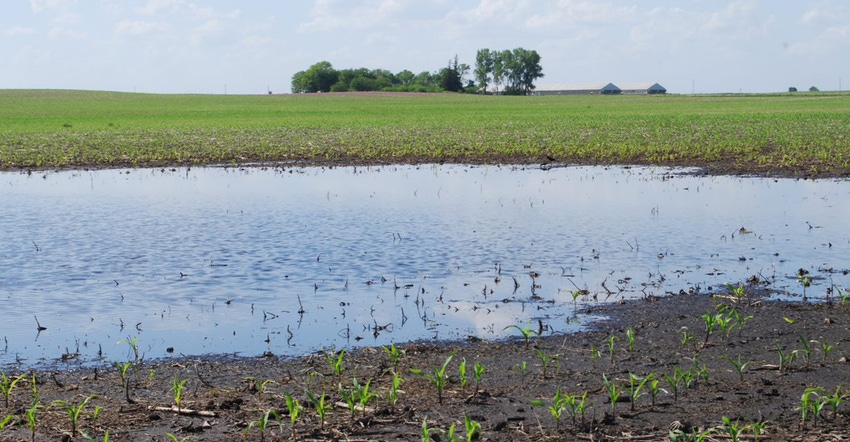June 11, 2019

By Patrick Hatting
The devastating floods, tornadoes and wet planting conditions throughout much of the Corn Belt in 2019 increases the concerns lenders have for their borrowers. Floodwaters stripped soil from the land needed to grow crops and pasture for livestock. It could take years to return some of this land to full production.
Many farmers are storing larger volumes of grain for multiple years in anticipation of better prices. A few saw floodwaters that eroded their land and contaminated that grain. However, multiperil crop insurance policies do not cover stored grain. These policies can provide annual revenue guarantees on crops. This can cushion against unknown naturally occurring disasters but will not provide additional income to support households.
Farmers and ranchers had already weathered five years of decline in net farm income before these weather disasters. During this same five-year period, farm debt has increased by nearly a third to levels not seen since the 1980s. The farm economy is expected to remain fragile in 2019, as farm profit margins remain tight, production costs are slow to decline and Chinese tariffs continue to limit U.S. trade. Combine these tough financial concerns with this spring’s weather disasters, and those affected will suffer both physical and emotional distress.
Risk management help
Farm and ranch families are often sustained through their hope and optimism from one year to the next. When natural disasters hit, and finances get tight, there is often a rise in anxiety and depression. Lenders could prove critical in helping their borrowers understand the multitude of risk management tools available.
By late this summer, two new federally funded programs will provide financial assistance to those impacted by these natural disasters, as well as the ongoing Chinese tariffs on U.S. farm production. In addition, annual multiperil crop insurance coverage provides farmers payments on replant, delayed and prevented planting acres. More information on this coverage follows:
New federal disaster funds. In early June, Congress passed Disaster Relief funding totaling $19.1 billion. The new law authorizes USDA to distribute $3 billion for farmer losses stemming from 2018 and 2019 disasters, including grain destroyed by floodwaters. It provides the Emergency Conservation Program with $558 million and the Emergency Watershed Protection Program with $435 million. Also, for the Army Corps of Engineers, this law provides just under $2.5 billion total for various flood and hurricane controls, including repairs and emergency operations, as well maintenance and natural disaster repairs, such as levees along the Missouri and Mississippi rivers.
2019 Market Facilitation Program. On May 23, USDA revealed a second year of tariff aid payments under the Market Facilitation Program totaling $14.5 billion. These payments will go to farmers who produce commodity crops, as well as dairy and hogs. The direct payments for crops will be based on reported 2019 planted acres for each farm, but can’t exceed that farm’s 2018 plantings.
Each county will be assigned an MFP payment rate based on historical production. All growers in a county will receive the same rate, regardless of the eligible crop grown, but must plant their 2019 crops. Program payments will be split into three rounds, the first coming by August. The second payment would come in late fall and the third payment in early 2020. The latter two rounds of payments could be canceled if the U.S. and China can resolve their trade dispute.
2018 Farm Bill programs. This new five-year federal law was enacted in December 2018 and is currently being implemented by USDA. Funding includes over $6 billion annually for commodity crop and livestock programs including the Agriculture Risk Coverage and Price Loss Coverage programs for crops, and improvements to the Livestock Indemnity Program.
The farm bill provides over $7 billion annually for crop insurance programs, as farmers will continue to receive crop insurance subsidies. They typically purchase farm-level revenue protection products that guarantee revenue using the farm’s actual production history times their choice of coverage level times the higher of the projected spring price or the harvest price.
Multiperil crop insurance. Embedded in these crop insurance policies is coverage for replant, delayed and prevented planting. A farmer unable to plant an insured crop can still receive up to 55% of the original revenue guarantee for corn and 60% of the original guarantee for soybeans. These payments are based on the spring projected prices of $4 per bushel for corn and $9.54 per bushel for soybeans, respectively.
For more information on crop insurance, prevented planting provisions, and tools to help make risk management and farm financial decisions, visit ISU’s Ag Decision Maker website.
Stay tuned
The new federal disaster law specifically covers “crops prevented from planting in 2019” and grain lost to flooding while stored on the farm. While there has been talk about increasing the guarantee for prevented planting acres as a supplement to financial assistance provided by USDA’s Market Facilitation Program, it should be noted that $3 billion as provided by the new law isn’t a large pool of funding once it is spread across several states and several disasters. It will still take some time for USDA to adopt rules to implement this new disaster law.
It is also unclear how widely the increased prevented planting payments could be distributed in a year when the number of prevented planting acres is expected to be millions of acres larger than usual.
USDA officials say they are looking for creative ways to provide additional aid for unplanted acres, such as utilizing the CCC Charter Act. Also, USDA is continuing to fine-tune the county payment system for MFP, which is why those acres haven’t been announced yet.
Hatting is the Iowa State University Extension farm management specialist for southwest Iowa. Contact him at [email protected].
You May Also Like




